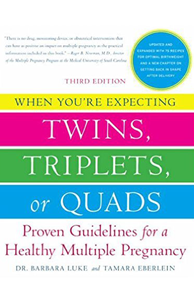The first day of medical school, an Associate Dean of Something invariably trots out with a lecture proclaiming that half of what we’re about to learn will be proven wrong in the next ten years. Everyone, who has ever worked with me, knows how much I detest induction of labor (IOL). I have been ruining OB board check-outs for 30 years with ranting, raving, whining and grumbling over what I considered “ill-advised” inductions. It wasn’t anything personal. I wasn’t a failed induction of labor cesarean baby who never got to breastfeed. After years of practice, and an overstuffed file of clinical studies comparing IOL to spontaneous labor, I was a true believer. The counter-productivity of elective labor induction, particularly for a woman’s first delivery, was on my short list of things I knew “for sure.”
Just a couple of days ago, my friend Bill Grobman published the ARRIVE trial in the New England Journal of Medicine. Sponsored by the Eunice Kennedy Shriver National Institute of Child Health and Human Development and the Maternal-Fetal Medicine Units Network, it is a beautiful study. Large, rigorous, multi-centered, prospective, randomized and well-analyzed trial run by a brilliant, hardworking, dedicated and unfailingly fair investigator. Within the inner circle of academic hotshots, we accurately describe it as being Level 1 evidence. Like the Chicago Black Sox scandal, I was left brokenhearted on the street pleading, “Say it ain’t so, Bill.”
First off, let’s briefly review what was convincingly demostrated by the ARRIVE study. Six thousand one hundred and six women at 41 academic and community-based hospitals having their first child, without any obstetrical or medical complications, and with exceptionally good dating of their pregnancies were randomized to one of two management options. Between 38 weeks 0 days and 38 weeks 6 days women were assigned by chance to either IOL between 39 weeks 0 days and 39 weeks 4 days OR to a plan of expectant management. Women in the expectant management group were to wait for spontaneous labor until at least 40 weeks 5 days unless significant complications arose. More than sixty percent of the enrolled women had what we call an unfavorable cervix (Bishop score < 5) which were the women we had previously tried hardest to avoid induction because of the presumed greatest risk of failure. For women having their first child with an unfavorable cervix, we believed that the risk of cesarean delivery was at least 2-fold, if not 3 times higher, than for women who went into spontaneous labor.
The results were stunning. The primary study outcome was a composite of perinatal mortality or severe neonatal morbidity.That composite was a long list of uncommon, but serious health issues, that worry all obstetricians and employs neonatologists. This composite outcome was reduced by 20% in the induction group (4.3% IOL group versus 5.4% in expectant group; p=0.049). This difference did not quite reach a pre-specified cut-off for statistical significance, but it is a notable reduction. Even if the improvement in newborn outcome did occur by chance alone, the results are far different from what was expected- an increased frequency of complications in the pregnancies undergoing IOL.
The other outcome of interest involved maternal complications. Remarkably, the cesarean delivery rate was significantly reduced in the induction group (18.6%) compared to those women who awaited spontaneous labor (22.2%; p<0.001). Additionally, the diagnosis of hypertensive disorders of pregnancy (pre-eclampsia and gestational hypertension) was also significantly lower among the induced women (9.1%) compared to those who waited for labor (14.1%; p<0.001). As opposed to everything I’d ever told residents or students, a policy of elective IOL at 39 weeks for low-risk nulliparous women would prevent one cesarean for every 28 women induced compared to awaiting spontaneous labor.
In response to the publication of this paper, the American Congress of Obstetrics and Gynecology and the Society for Maternal-Fetal Medicine issued a joint opinion statement. The organizations stated that it was reasonable to offer an elective induction of labor to low risk, nulliparous women at or beyond 39 weeks 0 days gestation assuming they meet the dating and eligibility criteria of the ARRIVE trial. Without a doubt, there will be women who’ll prefer to go into labor on their own. But mostly, I believe that women will be all over this option like a fat boy on a double-stuffed Oreo after school. Whether due to anxiety, pregnancy discomfort, scheduling convenience, desire to assure a specific attending obstetrician, or maybe because IOL lowers the cesarean risk and may be safer for her newborn as evidenced by the ARRIVE trial, women are going to opt for induction in large numbers. I’m certain that this study will herald one of the most significant changes in Obstetric practice in my lifetime.
My mind is changed. This is probably only remarkable in that many would argue that I’ve never changed my mind. However, I am left with some cautionary concerns. Inductions of labor are associated with a longer stay on the L&D units than women who arrive in spontaneous labor. They require more nursing attention, more interventions and consume more hospital resources. Algorithms that determine the number of delivery rooms or nurses needed for a given number of deliveries need to be adjusted upward if the number of labor inductions increase significantly. Undersized and understaffed L&D units are dangerous places, and are not the same places as the premiere obstetrical services that performed the ARRIVE trial. The adjustments needed to serve an obstetrical population with a 30-40%, or higher, IOL rate still need to be determined, and then met by hospitals that promote this approach. I fear that our new L&D unit currently under construction will be too small the day it opens.
My second concern has already been voiced in the ACOG-SMFM joint position paper. They recommend that research be conducted to measure the impact of this practice outside the setting of a clinical trial. Among the 41 participating centers there were some large community hospitals. However, the study was designed, directed and dominated by the academic centers who are members of the Maternal-Fetal Medicine Units Network. In general, obstetrical management of study participants was left to the discretion of the obstetrical providers. However, the study protocol recommended waiting at least 12 hours after cervical ripening, rupture of membranes or starting Pitocin before recommending a cesarean due to “failed induction” in the early phases of labor. Making this approach successful requires patience on the part of providers in the induction of labor cases. In academic centers and large community-based hospitals, there is 24/7 resident physician coverage which makes patience easy. In smaller private hospitals where women have a single provider, waiting at least 12 or 24 hours, for delivery, makes patience a much more elusive commodity. It should be easy, and it is a necessity, that the impact of this more liberal IOL policy (which started this week) on cesarean rates for low risk, nulliparous women be evaluated using a pre- and post intervention study design. There are so many provider and patient human variables, we need to prove these benefits are still achieved outside of a stringent randomized clinical trial.
Lastly, is the medico-legal concern. I have again told residents for years that the seven most dangerous words in Obstetrics are, “Patient admitted for elective induction of labor.” Not often, but sometimes, really bad stuff can happen during labor and delivery. The rate of composite serious adverse newborn outcomes was between 4-5% in the ARRIVE trial. It is dangerous hubris to believe that we can manage all the complexities of labor and prevent them. Even at these elite medical centers, something did not turn out as expected in one out of 20 low-risk, nulliparous deliveries. Importantly, these adverse outcomes occurred in both the induced and spontaneous deliveries. They are going to happen regardless of our labor induction choice. However, I’ve done enough medico-legal reviews to know that once you admit a patient for an elective IOL you’ve then accepted responsibility for everything that comes after. After 30 hours of induced labor, I can promise you that the plaintiff lawyer and expert can find a 30 minute window where the patient averaged 6 contractions per hour. “Right there” was when the kid developed autism. There wouldn’t have been a shoulder dystocia if labor hadn’t been induced. The long induced labor “depleted the fetal reserves” and caused the meconium aspiration syndrome and resulting pneumothorax. Not quite as easy to track, but it will be fascinating to see if this change in obstetrical management influences the trend in medico-legal litigation.
In the past two decades, we’ve decided that no pregnancy should be allowed to go beyond 41 weeks gestation. Dichorionic twins are best delivered at 38 weeks gestation and monochorionic twins at best delivered at 37 weeks. Now it seems that uncomplicated first pregnancies are best delivered by induction of labor at 39 weeks. I hope it’s true and the benefits are real. I do worry when we try to outsmart a million years of human evolution. I’m reminded of the old Chiffon Margarine commercial which warns, “It’s not nice to fool Mother Nature.” I worry that Mother Nature will figure out a way to punish us for this decision in ways we haven’t anticipated.
I’m also reminded again of that first medical school lecture when they told us that 50% of what we’re taught is wrong. They just forget to tell us how to figure out which half it is. Time, however, always tells. But, for the short term, I’ve decided to quit bitching about the scheduled 39 week inductions.
In selecting a Bruce Springsteen song appropriate for this topic I had to go with a relatively obscure song from the Lucky Town album not frequently played in concert. The video is also cool because it shows how Springsteen will take audience requests for songs of his, or other artists, that the E Street Band may have never played or not played in 20 years. “Living Proof” was written soon after the birth of his first child which is, of course, what makes it my selection. The truth Springsteen discovers is that children are both life and love and “restore the faith, that I’d lost in myself.” It is a solemn song and Bruce’s voice carries exultation and relief buoyed by fabulous guitar chords. “Searching for just a little bit of God’s mercy; I found living proof.”
Dr. Newman is a Professor of Obstetric and Gynecology and Maas Endowed Chair of Reproductive Sciences at the Medical University of South Carolina. However, these opinions are his alone, and do not necessarily represent those of his employer.








I think it was first year of my fellowship – I convinced you that 41 weeks was the endpoint for pregnancy if well dated! Now, we have this! As an interesting followup, one would wonder if you took the highest risk IUFD subset of the “low risk nullipara” and intervened with IOL at 39 to 39 4/7 weeks, would we impact the adverse outcome rate in that group. Women of color, women of increased BMI, ect . . .